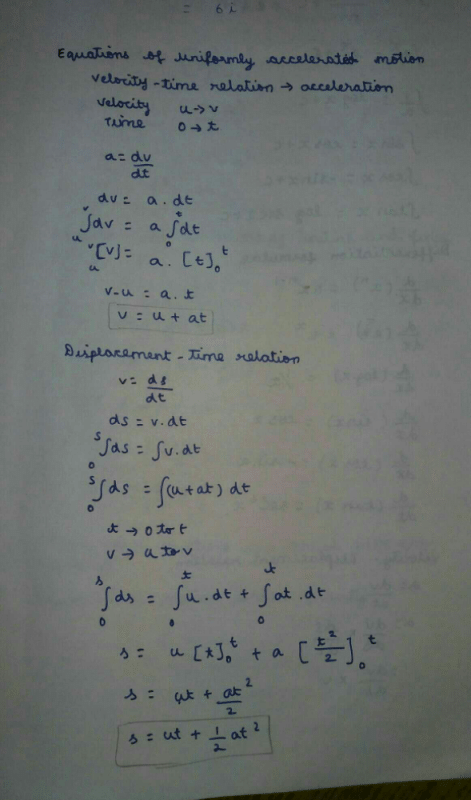Class 11 Exam > Class 11 Questions > Derive second equation of motion by calculus ...
Start Learning for Free
Derive second equation of motion by calculus method?
Most Upvoted Answer
Derive second equation of motion by calculus method?

Community Answer
Derive second equation of motion by calculus method?
Derivation of Second Equation of Motion
The second equation of motion is given as:
v = u + at
Step 1: Define Variables
We define the following variables:
- u: Initial velocity of the object
- v: Final velocity of the object
- a: Acceleration of the object
- t: Time taken for the object to travel from initial velocity to final velocity
Step 2: Derive Average Velocity
The average velocity of the object is given by:
avg. velocity = (u+v)/2
Step 3: Derive Displacement
The displacement of the object is given by:
displacement = avg. velocity * t
displacement = (u+v)/2 * t
Step 4: Derive Second Equation of Motion
The second equation of motion is derived by using the following equation:
v^2 = u^2 + 2ad
where, d is the displacement of the object.
Substituting the value of displacement from step 3, we get:
v^2 = u^2 + 2a(u+v)/2 * t
v^2 = u^2 + at(u+v)
Dividing both sides by v-u, we get:
v+u = at
or, v = u + at
Step 5: Conclusion
Thus, the second equation of motion is derived using the calculus method.

|
Explore Courses for Class 11 exam
|

|
Question Description
Derive second equation of motion by calculus method? for Class 11 2025 is part of Class 11 preparation. The Question and answers have been prepared according to the Class 11 exam syllabus. Information about Derive second equation of motion by calculus method? covers all topics & solutions for Class 11 2025 Exam. Find important definitions, questions, meanings, examples, exercises and tests below for Derive second equation of motion by calculus method?.
Derive second equation of motion by calculus method? for Class 11 2025 is part of Class 11 preparation. The Question and answers have been prepared according to the Class 11 exam syllabus. Information about Derive second equation of motion by calculus method? covers all topics & solutions for Class 11 2025 Exam. Find important definitions, questions, meanings, examples, exercises and tests below for Derive second equation of motion by calculus method?.
Solutions for Derive second equation of motion by calculus method? in English & in Hindi are available as part of our courses for Class 11.
Download more important topics, notes, lectures and mock test series for Class 11 Exam by signing up for free.
Here you can find the meaning of Derive second equation of motion by calculus method? defined & explained in the simplest way possible. Besides giving the explanation of
Derive second equation of motion by calculus method?, a detailed solution for Derive second equation of motion by calculus method? has been provided alongside types of Derive second equation of motion by calculus method? theory, EduRev gives you an
ample number of questions to practice Derive second equation of motion by calculus method? tests, examples and also practice Class 11 tests.

|
Explore Courses for Class 11 exam
|

|
Signup for Free!
Signup to see your scores go up within 7 days! Learn & Practice with 1000+ FREE Notes, Videos & Tests.


















